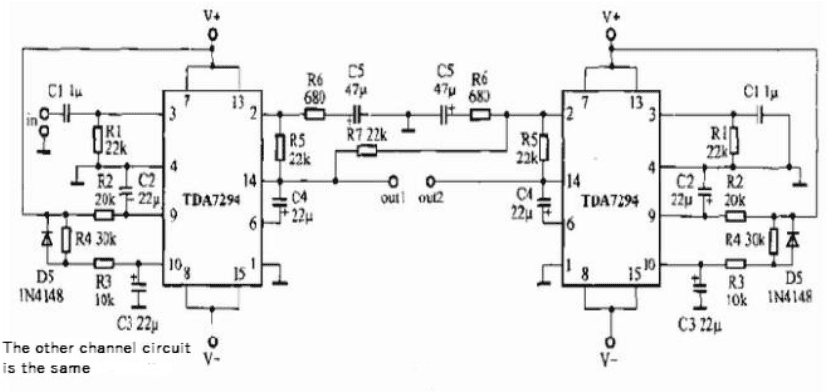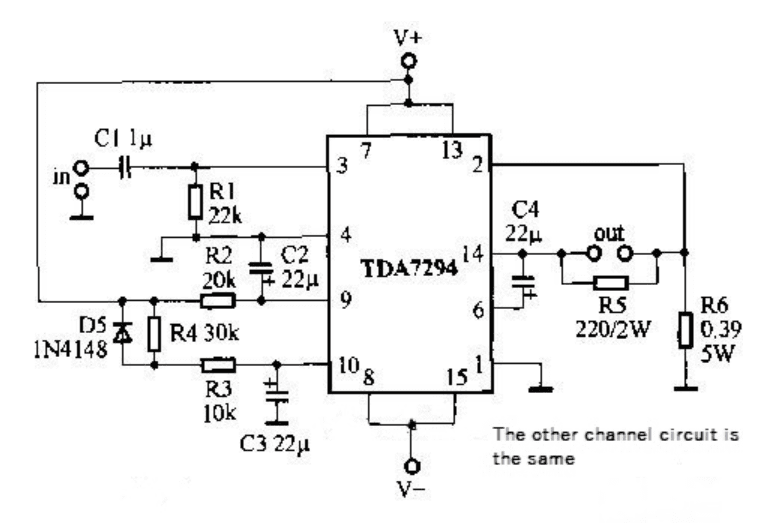Table of Contents:
It’s not hard to see that among audio equipment enthusiasts, numerous are also electronics enthusiasts who design, repair and build amplifiers, preamplifiers, loudspeakers and all the other devices and components that make it possible to play and reproduce music.
Although audio amplifiers based on discrete components continue to enjoy unflagging popularity, you can’t go wrong with audio amplifiers that use a simpler design solution in the form of a monolithic integrated circuit, and that is the TDA7294 – we’ll take a look at several audio amplifier designs based on this IC!
TDA7294 - general characteristics of the circuit
The TDA7294 is a highly innovative high-power audio amplifier IC with D-MOS technology, launched by the famous European company SGS-THOMSON STMicroelectronics in the 1990s.
last century.
The refined design of this amplifier, removes the harsh, cold and hard harmonics known from previous generations of linear integrated power amplifiers and thick-layer integration, and is widely used in HI-FI applications such as home theaters, active sound systems, etc.
The design of this chip combines the advantages of a bipolar signal processing circuit and a power MOSFET.
The chip features increased resistance to higher supply voltages, low noise, low distortion and high fidelity sound reproduction.
The circuit also features stand-by, short-circuit and overheat protection, so its performance is greatly improved.
The main parameters of this integrated amplifier are:
- VS (supply voltage) ±10~±40V (maximum voltage without signal ±50V);
- Io (peak output current) 10A;
- Po (continuous RMS output power) 70W at VS=±35 and Z=8 Ω; 70W at ±27V and Z = 4Ω; 100W at VS=±38V and Z = 8Ω; and 100W at VS=±29V and Z = 4Ω.
The stand-by and mute circuit completely reduces power-on and power-off noise and eliminates overheating of the speaker protection circuit, short-circuit current protection and other features that make its performance excellent.
This device is suitable for home theater and Hi-Fi amplifiers.
TDA7294 - OCL chip
The circuit diagram of the amplifier in the OCL circuit is shown in Figure 1.
The circuit is a two-channel 70-watt power amplifier composed of two TDA7294 chips.
The circuit contains more than a dozen external components necessary for proper operation.
When the supply voltage is ±35 V, we can obtain a continuous output power of 70 W into an 8-ohm load.
This is a very suitable circuit for driving speakers in a room of up to 30m2.
If the speaker impedance is less than 8 ohms, the supply voltage of the circuit should be reduced accordingly.
TDA7294 - BTL chip
The BTL circuit is shown in Figure 2.
It uses two TDA7294 circuits operating in a bridge topology.
The output power of such a circuit can reach even more than 150W.
It is well suited for small concert halls.
To play stereo, a total of four pieces of the TDA7294 chip are needed.
When the supply voltage is ±25 V, a continuous output power of 150 W can be achieved with an 8-ohm load.
When the supply voltage is ±35 V, you can get a continuous output power of 180 W into a 16-ohm load.
When you use the TDA7294 as a BTL power amplifier, the load must not be less than 8 ohms.
TDA7294 - constant-current amplifier
This power amplifier circuit on the TDA7294 is slightly different from the previous two designs.
Its feedback circuit includes current sampling, voltage summing and negative feedback.
Compared with the traditional constant-voltage power amplifier, the constant-current amplifier has the following advantages:
- The output current of a power amplifier does not depend on the load impedance.
Even if the load is short-circuited, it will not cause the amplifier to overheat. - The output power increases as the load impedance increases.
Increasing the speaker load within a certain power reserve can ensure the bass power and high-frequency resolution of the original music signal. - The force acting on the speaker’s voice coil depends solely on the current.
The use of fluid-controlled oscillations to promote the speaker must be faster than voltage-controlled oscillations so that the input and output impedance of the speaker vibration system can be easily adjusted. - The DC power amplifier circuit is actually a controlled current source controlled by the input signal voltage.
Its internal feedback circuit implements current sampling, summing the negative feedback voltage, and has high input and output impedance.
The input impedance is high, exactly what the amplifier circuit needs with a constant voltage of the previous stage, which is advantageous for sending the signal voltage to the input of the power amplifier without losses.
The high output impedance can be reduced by the resistance of shunt R5, which is conducive to adding output signal current to the load.
In Figure 3, the supply voltage is chosen as ±35V, and its magnification is determined by the ratio of the speaker to R6.
TDA7294 - not just for listening to music!
The sample circuits presented in this article, based on the TDA7294 chip, provide very good sound quality whether listening to music or watching movies.
However, the applications of this circuit do not end there.
We can also successfully use it in amplifiers designed for amplifying electric musical instruments, such as guitars, synthesizers and many others.
The circuit can be used with both solid-state and tube-based preamplifiers – the latter can be found, for example, in Marshall’s Valvestate series of guitar amplifiers.
How useful was this post?
Click on a star to rate it!
Average rating 5 / 5. Vote count: 2
No votes so far! Be the first to rate this post.























